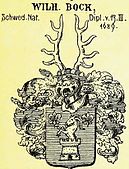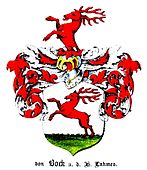Bock adH Lachmes

Bock is the name of a Baltic noble family , which in the second half of the sixteenth century from Lower Silesia coming in Livonia and Estonia was besitzlich. Branches of the family currently persist.
There is no tribal relationship with the v. Bock adH Suddenbach , who already appeared in the Baltic States during the men's championship . Likewise, a similar one with the Silesian Bock and Polach is not known, but due to the common homeland and the relationship of the coat of arms, it cannot be ruled out.
history
Wolmar Bock, Herr auf Gröneichen in the principality of Breslau , moved to Livonia in the second half of the 16th century and did military service against the Muscovites on the Swedish side .
The family v. Bock adH Lachmes then belonged to the hereditary knighthood in Livonia since the royal Polish reign (1561–1629).
The royal Swedish colonel and co-lord of Kersel and Willust in Estonia, as well as bards in Sweden, Wilhelm Bock (* 1618; † 1689), was naturalized in Sweden in 1689 and introduced to the nobility class of Swedish knighthood as Bock från Lachmes (sub no. 1174).
The enrollment in the Livonian aristocratic registers took place in 1745 (sub no. 56) for the entire family. Enrollment in the knighthood in Estonia took place on February 15, 1818 for Heinrich von Bock (1771–1863), Herr auf Kersel and Heinrich Berend Wilhelm von Bock (1781–1857), Herr auf Sellie.
Historical property
The family owned the following goods in Estonia:
Alexandershof (1891–1899) in the parish of Pölwe ; Arrohof (1796–1820) in the parish of Nüggen ; New Bornhusen (1833–1919) in the parish of Hallist ; Engdes (1866–1876) and Nömme (1817–1829) in the parish of Klein St. Marien ; Enge (1866–1876) and Lachmes (1599–1919) in the parish of Groß St. Johannis; Kechtel (1730–1772) in the parish of Rappel ; Kersel (1679–1919), Schwarzhof (1741–1912), Willust (1679–1799) in the parish of Paistel ; Alt Köllitz, (1861– ante 1873) in the parish of Cannapäh ; Kuckulin (1853-1860) in the parish of Ecks; Ledis (1842–1854), Restfer (1828–1854) and Waimastfer (1799–1817) in the parish of Lais ; Ninigal (1732–1919) in the Fellin – Land parish ; Paenküll (1777–1822) in the Merjama parish ; Sellie in the parish of St. Simonis ; Woiseck (1748–1837) in the parish of Klein St. Johannis
coat of arms
The family coat of arms shows a right-handed red stag freely in the shield. On the helmet with red and silver covers over a red and silver puffed -up , the deer growing. Occasionally the shield was also tinged with silver . The green ground only came with Hupel . However, the family orientates itself on the coat of arms as it was emblazoned at the matriculation in 1747 .
- The coat of arms in historical illustrations
Coat of arms of the Swedish buck fran Lachmes after Gritzner . During the naturalization in Sweden in 1689, the awarded coat of arms was changed considerably.
Coat of arms of the Bock adH Lachmes according to enrollment with the Estonian knighthood in 1818
Name bearer
- Berend Johann von Bock (* 1701; † 1769), 1742–1769 Livonian district administrator, Pernau head of the church and 1745 state deputy in St. Petersburg
- Gustav Jacob von Bock (* 1730; † 1768), Imperial Russian general
- Georg Karl Heinrich von Bock (* 1758, † 1812), the beautiful district marshal , imperial Russian lieutenant captain of the bodyguard of Catherine II the Great , councilor, administrator of the war hospitals, introduced the first threshing machine in Russia, owner of the first Russian mirror and glass factory
- Heinrich August von Bock (* 1771; † 1863), 1817–1820 district judge in Pernau, 1819 knight of the Order of St. Vladimir IV. Class, 1827–1847 Livonian district administrator, author on political issues
- Timotheus Eberhard von Bock (* 1787, † 1836), Imperial Russian Rittmeister of the Guard Hussars and dissident
- Woldemar Bernhard Wilhelm Georg Heinrich von Bock (* 1816; † 1903), Vice-President of the Livonian court in Riga and composer
- Heinrich Anton Hermann Karl Peter Moritz von Bock (* 1818; † 1903), 1867–1872 and 1884–1887 Livonian District Administrator, 1872–1884 Livonian Land Marshal, Imperial Russian Chamberlain, Real Councilor of State, Knight of the Stanislaus Order, First Class
- Georg von Bock (* 1818; † 1876), Vice Admiral in the Imperial Russian Navy
- Gustav Wilhelm von Bock (* 1823; † 1900), architect, including the university church in Dorpat
- Dr. med. Friedrich Wilhelm von Bock (* 1824; † 1904), Imperial Russian Real Councilor of State and Mayor of Dorpat
- Prof. Alexander Friedrich von Bock (* 1829, † 1895), Imperial Russian Real Councilor of State , sculptor, professor of sculpture at the Academy of Arts in St. Petersburg, Knight of the Order of St. Vladimir III. class
- Wladimir von Bock (* 1850, † 1899), Imperial Russian Real Councilor of State, archaeologist and coptologist
literature
- Genealogical manual of the Baltic knighthoods . Part 1, 1: Livonia. Görlitz 1929, pp 569-584 ( personen.digitale-sammlungen.de ).
- Genealogical manual of the Baltic knighthoods. Part 2, 1.2: Estonia. Görlitz 1930, p. 228 ( daten.digitale-sammlungen.de ).
- Genealogical handbook of noble houses . AB XXIII, Volume 121 of the complete series. CA Starke Verlag, Limburg ad Lahn 2000.
- August Wilhelm Hupel : Materials on an Estonian aristocratic history. In: Nordic Miscellanees . St. 18–19, Riga 1789, pp. 54–59. ( books.google.ee ).
- Carl Arvid von Klingspor : Baltic heraldic book. Stockholm 1882, p. 70. ( Personen.digitale-sammlungen.de )
- Johan Adam Rehbinder, Carl Fredric Rothlieb: Matrikel öfwer Swea Rikes Ridderskap och Adel, ifrån 1755 til närwarande tid…. Volume 2: Matrikel innehållande en fortsattning om Swea Rikes introducerade Ridderskap och Adel 1782, p. 864 (Swedish: books.google.ee )
- Das Inland 1836–1863, a weekly for Liv-, Esth- u. Curland's History of Geography, Statistics and Literature. therein texts to and from members of the families v. Bock adH Lachmes ( dspace.utlib.ee )
- Baltic Historical Commission (Ed.): Entry to Bock adH Lachmes. In: BBLD - Baltic Biographical Lexicon digital
Individual evidence
- ↑ History of goods (Estonian)


